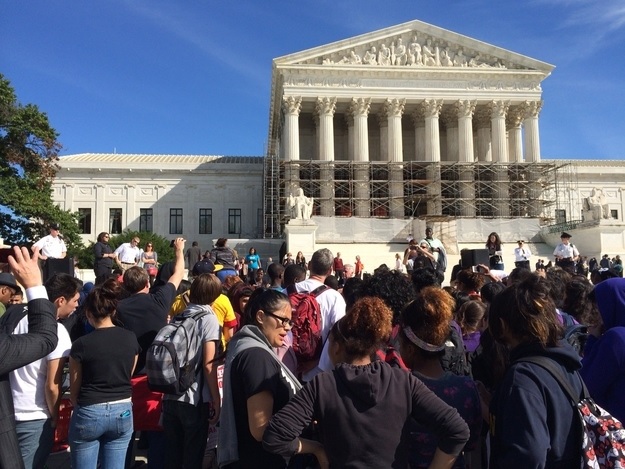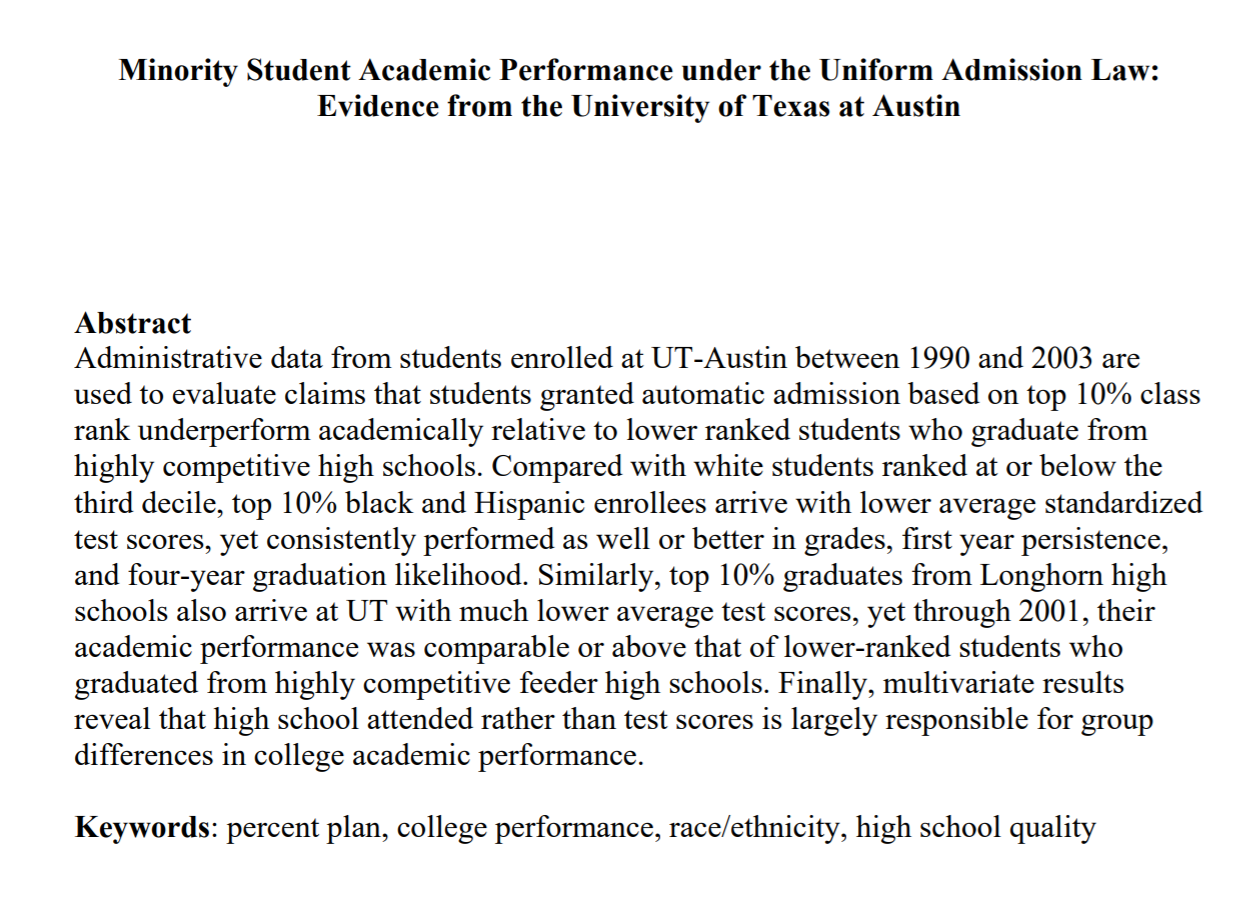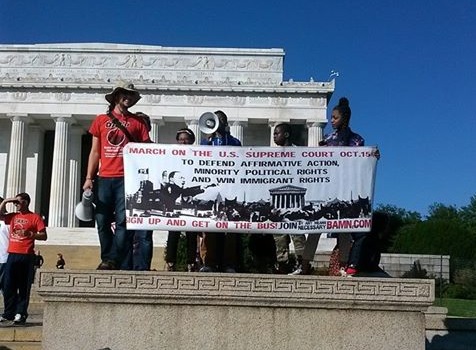Why We Must Defend Affirmative Action
The Origin and Impact of
Affirmative Action
(From BAMN’s Liberator #1 – Used to organize for the historic Grutter v. Bollinger trial)
The Civil Rights Movement and urban uprisings that swept the nation during the 1950s and 60s forced the government at every level to adopt the set of policies known as affirmative action. An executive order from Lyndon Johnson’s administration in September 1965 following the Watts rebellion was its first real legal foundation.
The term affirmative action applies to the entire set of policies and programs designed to overcome the institutionalized inequities of American society. Affirmative action includes a range of policies, from hiring parameters that result in a management giving priority to a woman or minority when filling an open position, to an institution being required to actively seek out applicants from underrepresented minorities or women. In admissions to higher education, affirmative action is a mechanism that compels administrations to take steps in the direction of integrating historically segregated institutions.
As a result of these policies, for the first time in American history, significant numbers of black and Latina/o people, with increasing numbers of other minorities, working-class people and women, gained access to historically segregated, elitist universities, jobs and other institutions. Through affirmative action, American society made an important, partial step toward integration and equality. Incomplete progress was made.
Affirmative action’s logical cornerstone is the necessity of an active remedy to discrimination and inequality codified in policy and law. Simply illegalizing discrimination is insufficient because the unreasonable burden of legally challenging abuses falls on the victimized individual.
Much of affirmative action is not law, but programs adopted voluntarily by various institutions under the pressure of the struggle for equality.
Affirmative action has been severely weakened since its inception. In the 1978 Bakke decision the Supreme Court ruled against quotas as a component of affirmative action but maintained that race could be considered as a factor in university and college admissions. The force of affirmative action programs was profoundly diminished by this decision.
The social inequality that affirmative action measures were proposed to offset still exists today. Now, 50 years after the Supreme Court ruling ordering the desegregation of education “with all deliberate speed”, separate, unequal schools still dominate American public education. Inequity of resources is profound. Deprivation stifles merit and potential. Class and racial barriers conspire to bar millions of youth from higher education.
The median black family in 2009 had a net worth of just $5,677, compared with $113,149 for whites. Black women are four times as likely to die during childbirth as white women. Black children and youth are almost four times as likely to be poor as their white counterparts.
The actual measures carried out in the name of affirmative action have never been comprehensive or powerful enough to uproot the pervasive racist and sexist inequality in our society, nonetheless, they represent an important step forward that must be defended.
FACT: The elimination of affirmative action leads to the resegregation of higher education.
At UC-Berkeley in Fall 2011, Latina/o, black, and Native American students were only 19% of incoming state-resident freshmen, while comprising 49% of California high-school graduates. This only flagship universities with a greater ratio of segregation were in the Deep South states of Louisiana, Mississippi, Alabama, Georgia and South Carolina.
UCB admitted 61% fewer underrepresented minorities in 1998—the year UC first implemented the ban on affirmative action in undergraduate admissions. 800 black, Latina/o, and Native American students with GPAs of 4.0 or higher were denied admission to the freshman class.
Latina/o, black, or Native American were 23 percent of new law students in UC in 1994, before the ban on affirmative action,. By 2005, this had fallen to 12 percent.
At UCB’s Haas Business School in 2010, black students were 1%, Latina/os were 8%, and Native Americans were 0% of new MBA students.
UC-Berkeley Freshmen (California residents)
2010 2011 High School Grads 2009
Black 141 (3.5%) 139 (3.5%) 6.8%
Chicano/Latino 554 (13.7%) 585 (14.8%) 41.0%
Native American 31 (0.8%) 34 (0.9%) 0.8%
Underrepresented
Minority Total 726 (17.9%) 758(19.1%) 48.6%
Total 4051 3960
Sources: UC Office of the President, Ed-Data: Education Data Partnership
 FACT: Standardized Tests do not measure “Merit”
FACT: Standardized Tests do not measure “Merit”
The SAT Subject Tests upon which UC relies have virtually no ability to predict college grades, predicting only 15.3% of the variation in first-year grades. They have no ability to predict grades beyond the first year or college graduation rates. (FairTest.org)
A study by the UCSD School of Medicine of the period 1968-1987 by shows that initial gaps in performance between its students admitted under the regular and affirmative action admission standards narrowed and disappeared over the course of medical education. (Journal of the American Medical Association, 278 (14))
Until the early 1970s, female students outscored male students on the verbal section of the SAT; the verbal section was “balanced” to produce minimally lower scores by women than men. The math section, which has consistently reflected a significant gap in favor of men, has never been “balanced.” (Carol Dwyer, The Reading Teacher, May 1976)
SAT-takers score on average 30 test points higher for every $10,000 in parental annual income.
FACT: Affirmative action programs opened up educational opportunities for all minorities and for women of all races.
Between 1911 and 1968, UCB’s Law School enrolled more than 6,000 students, but only 22 were black, 20 were Latina/o, and even fewer were Asian Americans and Native Americans. The first year Boalt expanded their affirmative action program (1968), it enrolled more black and Latina/o students than it had graduated in all prior years combined. (Andrea Guerrero, Silence at Boalt Hall: The Dismantling of Affirmative Action)
In 1960, a tiny number of all law students were women; today, just over 50% of law students are women. In 1971, women received 6.3% of all professional degrees. Ten years later, the figure had more than quadrupled to 27.5%.
MYTHS & FACTS about Affirmative Action
Myth: “Affirmative action should be based on socioeconomic status, not race or sex.”
Fact: First, programs that offset the disadvantages to which poor people of all races are subjected are not counterposed to race- and sex-based affirmative action. This is not an argument against affirmative action—it is an argument for expanding the scope of affirmative action.
For the racists who use the cover of the so-called “merit” argument to advance this proposal is sheer hypocrisy. Poor people of all races tend to do worse on the SAT and other standardized tests—so from the “logic” of their demagogy, programs that give “preferences” to people of “lower socioeconomic status” would mean that “unqualified poor people” are taking places that “qualified rich people should have gotten”.
This is a hypocritical attempt to conceal the elitist nature of the argument against affirmative action with a dishonest claim to speak in the interest of poor people of all races. The primary reason for the inaccessibility of higher education to poor people is money. The primary obstacle keeping poor white students specifically out of higher education is not the small number of black and other minority students—it’s money. If these racist hypocrites meant what they say, they would be fighting to lower tuition and expand grants and financial aid.
Second, racism and sexism are living factors in today’s society. Middle class and affluent black and other minority people face racism and middle class and affluent women of all races face sexism.
For years, the UC administration has considered socioeconomic status in admissions; however without the use of race the numbers of underrepresented minority students in UC remain pitifully low.
Myth: “Affirmative action is only an issue for black, Latina/o and other minority people.”
Fact: Women of all races have been the beneficiaries of affirmative action programs. Partial sexual integration of historically elitist, all-male institutions and jobs has resulted from the implementation of affirmative action policies and the struggle for equality generally. Recent Census Bureau reports indicate that median income for full-time working women was 74% of that for men. Affirmative action is also an issue for everyone who supports equality and justice in our society.
The number of women faculty decreased by 22% throughout the UC system after the takeaway of affirmative action. At UC-Berkeley, 81 percent of ladder-rank faculty are white; 73 percent of ladder-rank faculty are male.
Myth: “Affirmative action in college admissions acts too late—we should focus on ending inequality in K-12

education.”
Fact: The causes of unequal average-academic preparedness upon high school graduation between the so-called races are social—not genetic. Some opponents of affirmative action will immediately and honestly concede this point only to say that while the problem is social (i.e., racism), college is too late to remedy the problem. In the context of the ongoing attacks on the quality of education at all levels for poor people, and therefore disproportionately black, Latina/o and Native American students, the argument that affirmative action in college admissions is too late is really just a cynical evasion, even if some opponents of affirmative action do not realize it. To propose dismantling the gains we have made, supposedly because we have not achieved enough (not eliminated enough racist inequality) is an inconsistent and foolish argument. It is true that K-12 education must be improved, integrated and made equal—but that fact is no argument for resegregating higher education.
The unequal average-academic preparedness of high school graduates is a profound indictment of the segregation, inequality and inadequacy of our current K-12 education system, a system long-starved of the financial resources necessary to adequately carry out its task; the new civil rights movement must weigh in on this question.
Lastly, the same right-wing forces attempting to ban affirmative action in higher education are attempting to ban all desegregation programs in K-12 schools. People attempting to justify their campaign to outlaw integration programs for higher education by talking about inequality in K-12 play the part of arsonists lecturing the fire department. With people like this, hypocrisy knows no limits.
Myth: “Affirmative action creates a stigma of inferiority for its beneficiaries.”
Fact: The actual experience of the University of California shows that the opposite is true: admissions systems that artificially lower the number of underrepresented minority students intensify a racially hostile environment by increasing the isolation that underrepresented minority students experience and by giving direct support to the racist lie that black, Latina/o and Native American people are intellectually inferior to white people.
The stigma of inferiority comes from the discrimination, prejudice and inequality that necessitate affirmative action, not from affirmative action itself.
Myth: “Affirmative action hurts Asian Americans.”
Fact: Asian Pacific Americans (APAs) benefit from affirmative action programs because affirmative action has helped integrate this society and has undercut the influence of racist and sexist discrimination. In fields of study and work where APAs are underrepresented, affirmative action has been directly beneficial. Discrimination against APAs persists: college-educated APAs on average earn 11% less than their white counterparts, and high school-educated APAs earn 26% less than their white counterparts.
The inequalities created by the history of racism have created variation in how racism affects various racial and ethnic groups, including subgroups of APAs.
The defeat of affirmative action in the University of California system led to a decrease in Filipina/o, Pacific Islander, Chinese, Indian and Pakistani enrollment at UC Berkeley’s graduate programs. In 1994-1996, 13 Filipino students were enrolled in UCB’s Boalt Law School. In 1996-2000, after the elimination of affirmative action, only 3 Filipina/os were enrolled. A 2011 UC Riverside study documented that Asian American applicants were disproportionately turned down for management and leadership positions as equally-qualified whites. Only affirmative action can correct this systemic discrimination.
The defeat of affirmative action has also led to a increase in racist hate-crimes against APAs in the UC campuses.
Myth: “Affirmative action aids only wealthy women and minorities.”
Fact: Working-class and poor black, Latina/o and other minority people have benefited significantly from affirmative action policies in college admissions and hiring. Affirmative action as a factor in college admission offsets the weight given to standardized tests on which wealthier people of all races and both sexes tend to score higher than their poorer counterparts.
Racist and sexist discrimination affects all social classes—therefore the measures designed to offset racist and sexist discrimination are applied to all social classes.
Coalition to Defend Affirmative Action, Integration and Immigrant Rights and Fight for Equality
By Any Means Necessary (BAMN)
www.bamn.com IG: @joinbamn Facebook: bamnpage 855: 275-2266


